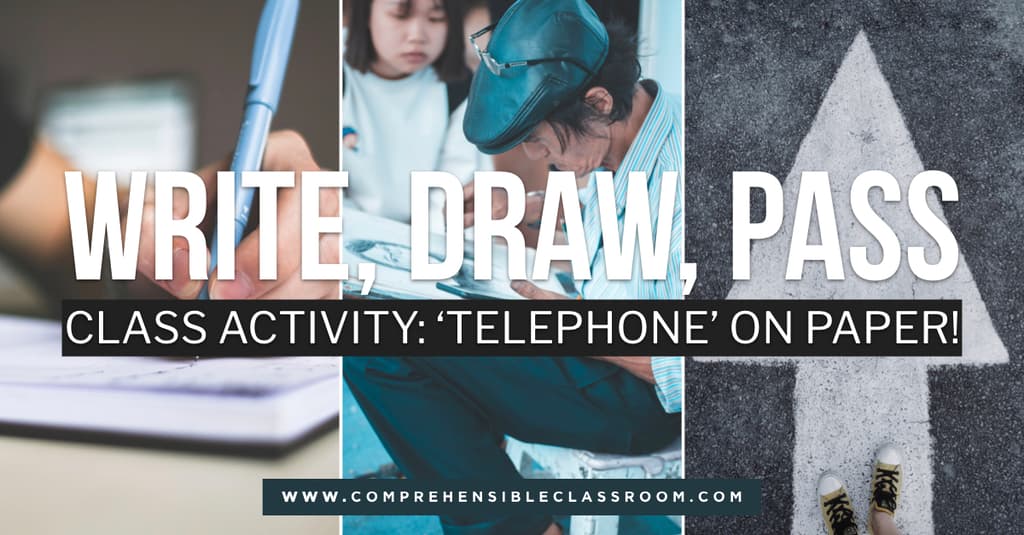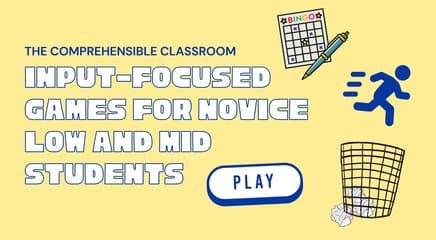I first played Write, Draw, Pass at our Bible Study end of the year party, and it quickly became one of my favorite party games! At a recent PD class, my colleague Ashley VanHemert pointed out how perfect it is to use as the starting point for communicative input in language classes! Ashley first made the connection for using this activity while in a class with Dr. Amy Wright at UAF (who also introduced me to Text Discovery). Write, Draw, Pass is a great game to play for Preferred Activity Time (PAT) or to use to review a text or class discussion. I'll show you how!

How to Play Write Draw Pass
When I first played this with my friends, we each had a pile of quarter-sheets of computer paper, numbered 1-8. Ashley played it with a single sheet of computer paper, folding it accordion-style 8+ times. I have found that what works best for my students in class is to use a FORM. With a form with numbered boxes to reference, it is super easy for the teacher to call out instructions and keep everyone doing what they are supposed to be doing when they are supposed to be doing it. So... use a form!
Print enough forms so that you have one per student (note that there are 2 forms per page– so if you have 30 students, you only need 15 copies), then distribute one per student.
Start playing: WRITE!
To get the game started, in Box #1, in the target language, ...
- Each student writes a creative, descriptive sentence (ex: a fat dog with big eyes runs to the store).
- Each student writes a descriptive word image (ex: a pretty girl with long hair)
- Each student copies or re-writes a sentence from a familiar text or a recent class lecture/discussion.
Now, PASS!
Have each student pass their paper (okay, make sure their name is on it first!) to the left.
If your students are seated in rows like mine often were, create a logical passing order that snakes through the classroom. Students will be passing papers to the same person multiple times throughout the activity, so it's worth it to make sure everyone knows to whom they are passing before you get started!!
Before passing, tell students to not discuss the papers with anyone else in class. The people to either side of each student should not ever know what is written or illustrated on their shoulder partners' papers!
Read and Draw
With a new paper in hand, each student READS what is written in Box #1 and DRAWS an illustration of the image or sentence in Box #2, as accurately as possible. Each student is now drawing on the paper that was passed to them–not their original paper!
Bury the evidence
Before passing this new paper on, each student should 'bury the evidence'. Do this by folding the top portion of the paper backward, hiding what is written in Box #1! Now, only boxes 2-7 are visible.
Another pass!
Each student now passes the paper that they just illustrated to their passing partner. If it's done correctly, every student should receive one new paper– the third for the class period (their original paper, then the one they illustrated, now a new one).
Look & Write
Each student now looks at their new paper; specifically, they look at the picture that was drawn in Box #2. WITHOUT FLIPPING OVER THE PAPER TO LOOK AT BOX #1 (the "buried evidence"), students now WRITE in Box #3. They should write their best guess as to what the original sentence written in Box #1, based only on the illustration drawn in Box #2.
EXAMPLE: Student A writes "A dog eats ice cream" in Box #1. Then, Student B draws a dog eating ice cream in Box #2. Next, Student C looks at the picture in Box #2 and thinks it looks like a crocodile eating a human, so they write "A crocodile attacks a human" in Box #3 (remember–they can't see what was written in Box #1!).
Bury the evidence & pass it on!
As before, students must fold under Box #2 (to hide it, along with Box #1) then pass the paper to the next person.
Keep writing, drawing, and passing!
Repeat the sequence until all boxes are filled. Each student should only see one completed box at a time–all other completed boxes should be folded backward.
The big reveal!
The BEST part of Write, Draw, Pass is the reveal!!
After all boxes are filled (or you run out of time), pass the papers back to the student that wrote the first sentence in Box #1. Everyone should unfold their paper and see just how far the sentence strayed from the original!
Share the laughs
My favorite thing to do is to collect all of the papers from my students (after they have seen them), and pull them up one at a time using the document camera to share the hilarity with the entire class!
See it in action!
Since publishing this post, we've received many requests for a video demo. Good news! My friend Spanish Mama shared a video of Write, Draw, Pass in action. Watch it here:
Twist: YOU write the sentences!
Is it early in the year and students don't have much language in their heads to draw from for output? Not confident in your students' ability to write intelligible sentences? Want to keep all sentences centered on a single theme?
Well, one solution is definitely to have students copy a sentence from a text (preferably a familiar one!).
Another way that I have solved these problems is to write my own starter sentences in Box #1 of each paper. Yes, that means writing as many as 35 unique sentences! I tended to do this for those topics that I knew I would be working with again, year after year.
Here is a set of sentences that I recently used in one of my classes:
- Harry cocina arroz con pollo. (Harry cooks rice with chicken.)
- Juan escribe, «Te amo, Sra. Williams» en un libro. (Juan writes, "I love you, Mrs. Williams" in a book.)
- Mis abuelos caminan al restaurante “Moose’s Tooth” (My grandparents walk to the restaurant "Moose's Tooth".)
- Yo miro la televisión a las tres de la mañana. (I watch TV at 3:00am.)
- Toda la clase lee el libro, ‘Don Quixote’ (The whole class reads the book, "Don Quijote")
- Ryan quiere el autógrafo de Eli Manning. (Ryan wants Eli Manning's autograph.)
- Daonapa duerme con sus cinco gatos. (Daonapa sleeps with her five cats.)
- Alejandra habla mucho en la clase de español. (Alejandra talks a lot in Spanish class.)
- See causa muchos problemas en la clase de histoira. (See causes a lot of problems in history class.)
- Mi papá habla por teléfono. (My dad talks on the phone.)
- Mis amigos van al cine para mirar “Never Say Never” (My friends go to the movies to watch "Never Say Never")
- Beyoncé canta enfrente de muchas personas. (Beyoncé sings in front of many people.)
- El Señor Brown grita a los estudiantes. (Mr. Brown yells at the students.)
- La Señora Bex come una pizza grande. (Mrs. Bex eats a big pizza.)
- El estudiante se sienta encima de un gato. (The student sits on top of a cat.)
- El niño tira un libro por la ventana. (The child throws a book through the window.)
- Mis padres celebran su aniversario. (My parents celebrate their anniversary.)
- ¡Hay un lobo en la clase de ciencias! (There is a wolf in science class!)
- La Señora Bex mira “American Idol” (Mrs. Bex watches American Idol.)
- Los muchachos bailan a la fiesta (The kids dance at the party.)
- Yo estudio el chino en la clase de español. (I study chinese in Spanish class.)
- El gato roba un sándwich de crema de maní. (The cat steals a PB sandwich.)
- Me duele el estómago. (My stomach hurts.)
- Jessica come un perro. (Jessica eats a dog.)
- Carlos habla francés en la clase de matemáticas. (Carlos speaks French in math class.)
- Veo una ambulancia desde la ventana. (I see an ambulance from the window.)
- La Señora Williams bebe café. (Mrs. Williams drinks coffee.)
- Nosotros vamos a un zoológico loco. (We go to a crazy zoo.)
- Un elefante baila el tango. (An elephant dances the tango.)
- Mi mamá canta las canciones de Justin Bieber. (My mom sings JB songs.)
Find another set, related to Summer Vacation, here!
More (silent) communicative activities
If you're looking for other activities that give the illusion of being communicative or interactive but do not involve talking, you will LOVE these:





